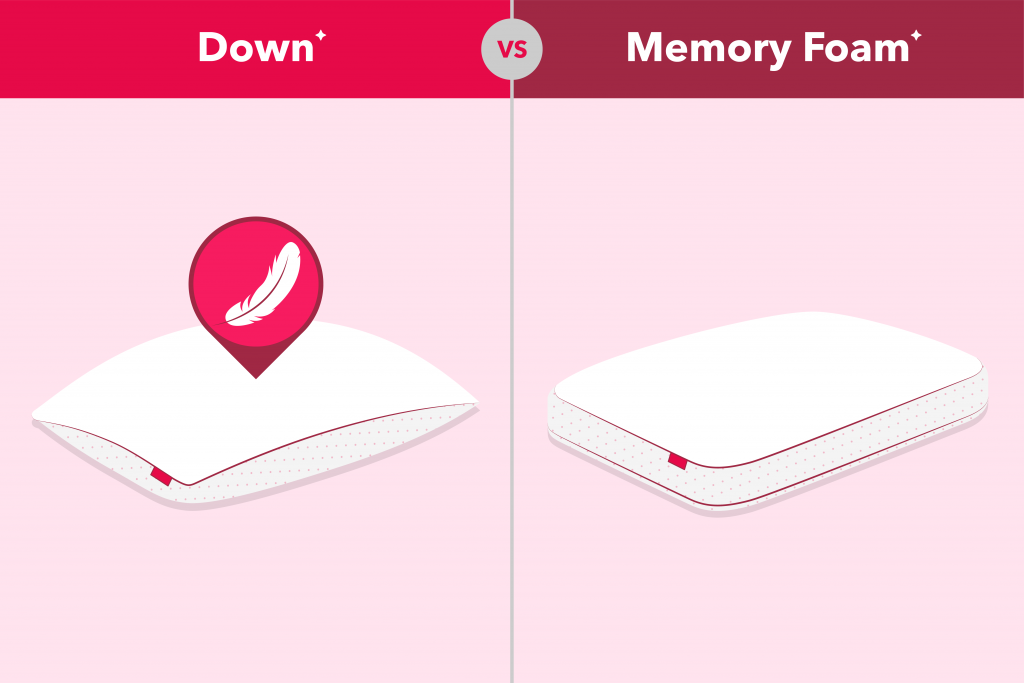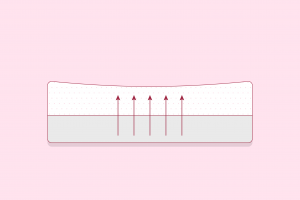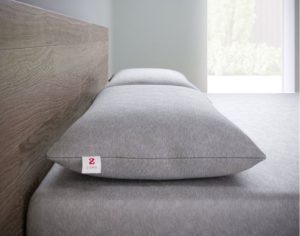Down vs. Memory Foam Pillow

Key Takeaways
- Material Characteristics: Natural down pillows are soft, lightweight, and easily adjustable, providing a squishy feel and scrunching down under the head. Memory foam pillows, on the other hand, are supportive, contouring, and offer added lift, making them suitable for those in need of more support, particularly side sleepers.
- Pros and Cons Comparison: Memory foam pillows tend to be better for allergy relief, while down pillows might trigger allergies due to dust and pollen accumulation. In terms of cost, memory foam pillows are relatively more affordable than down pillows. Durability-wise, down pillows outlast memory foam pillows, making them more cost-effective over the long run.
- Maintenance and Sustainability: Both down and memory foam pillows have specific care requirements. Down pillows need to be soak-washed with specialized detergent and air-dried, while memory foam pillows should be spot-cleaned and cannot be wet.
Natural down and memory foam are very different materials that create very different pillows. Down feather pillows are squishy, lightweight, and have tons of loft for people who love the look and feel of a thick pillow that scrunches down under their heads.
Memory foam pillows are supportive, contouring, and offer extra lift to those who need it (like side sleepers). Below, we’ll talk about the differences between these two pillow materials. We also discuss how to choose the right one for your needs.
Natural Down
 Down is a natural substance that comes from birds. Specifically, it’s the layer of fluffy feathers that keep birds warm in the winter or when they’re flying at high altitudes. Most down comes from either geese or ducks.
Down is a natural substance that comes from birds. Specifically, it’s the layer of fluffy feathers that keep birds warm in the winter or when they’re flying at high altitudes. Most down comes from either geese or ducks.
Typically, the down and other feathers of these birds are harvested when they’re slaughtered for food. Other methods of harvesting down include live-plucking or waiting for the birds to molt and gathering the feathers.
Unlike other feather types, down does not have a shaft (also called a quill) running through the center of each feather. That means down will never poke through the pillow cover as regular feathers do. This is one of the reasons down is so prized as a material for pillows and duvets.
Memory Foam
 Memory foam was initially designed by NASA to increase safety during high-speed flights. This particular kind of polyurethane foam can contour to your shape in a way that no other material can. That means, unlike with down pillows, you won’t ever have to fluff solid memory foam. However, shredded memory foam pillows can benefit from occasional fluffing.
Memory foam was initially designed by NASA to increase safety during high-speed flights. This particular kind of polyurethane foam can contour to your shape in a way that no other material can. That means, unlike with down pillows, you won’t ever have to fluff solid memory foam. However, shredded memory foam pillows can benefit from occasional fluffing.
Memory foam is made using petroleum products. This means it has to undergo significant purification during the manufacturing process to create a safe and non-toxic product. However, as long as your memory foam is CertiPUR-US certified, you can generally rest assured it is low in Volatile Organic Compounds and other potentially dangerous chemicals.
Natural Down vs. Memory Foam: Pros and Cons
When it comes to different measures of comfort, both down and memory foam win some and lose some. The best material for you depends on how you sleep and what you’re looking to get out of your pillow.
Allergy Relief
Memory foam has down beaten in this category. Down is an animal product that can actually trigger allergies in a small number of people. However, down’s real potential to trigger allergies lies in its tendency to collect dust and pollen. If you don’t properly clean and fluff down pillows, they can trap allergens in between the fluffy feather fibers and spew them back out later.
Meanwhile, memory foam actively fights allergens. Open-cell memory foam is breathable to wick away moisture. That makes it a hostile environment for bacteria and mold. It also resists common allergens like pollen and dust mites.
Cost
Memory foam also is superior to down when it comes to initial cost. Down pillows are expensive. Memory foam pillows are also not cheap either. But one of the best memory foam pillows can still save you up to $50 per pillow off the purchase price, when compared to down pillows.
Down pillows can cost anywhere from $80 to $200, while memory foam pillows will run between $50 and $150.
Durability
Down whips memory foam in this category. The average life expectancy of a memory foam pillow is only two or three years. Meanwhile, high-quality natural down can last a decade.
This makes down more affordable than memory foam in the long run. The initial cost of down is higher, but the fact that it lasts so much longer than memory foam means you’re paying less money per year to sleep on a down pillow.
Feel
This category is more dependent on your personal preferences. Down is squishy and fluffy. It will compress under your head when you lie on it. It also is customizable in the sense that you can easily fluff the pillow and alter its shape to fit your needs. This moldability makes down a good option for stomach and combo sleepers who need the ability to shape their pillows.
On the other hand, memory foam is sturdier and more supportive. It won’t squish underneath your head’s weight. Instead, it will mold itself to the shape of your head and neck. This means memory foam may be a better option than down for sleepers who need more support or contouring (like back and side sleepers).
Maintenance
If you’re looking for a pillow that’s super easy to care for, neither of these materials is your best bet. Down must be soak-washed in a bathtub or machine with no agitator. You have to use specialized down detergent. And down must be air-dried and fluffed, a process that can take many hours.
Meanwhile, a solid memory foam pillow can’t get wet at all. The best you can do is spot-clean stains on the cover with as little water as possible between trips to the dry cleaner.
However, a shredded memory foam pillow often is machine washable and you may even be able to tumble dry it on low heat. When it comes to an easy care routine, a shredded memory foam pillow can be a good choice. See our guide on how to wash pillows for more information.
Sustainability
Depending on how you look at it, either one of these materials could be the loser here. Down is a natural substance. So it’s lower in synthetic chemicals than memory foam. However, ducks and geese have to be fed, and they poop a lot, which produces a large amount of greenhouse gas. There’s also the cruelty factor, as live-plucking causes birds significant pain and distress.
Meanwhile, memory foam manufacturing produces lots of toxic waste. Also, unlike down, memory foam is not biodegradable. That means those pillows you toss in the garbage will probably be here in a thousand years.
Those looking for an eco-friendly and cruelty-free option might be better off going for a natural latex pillow instead of down or memory foam.
Best Memory Foam Pillow: The Zoma Pillow
 If you want a pillow that’s pliable and breathable like down but supportive and hypoallergenic like memory foam, you should take a look at the Zoma Pillow. The Zoma uses a combination of shredded foam and polyester fiber to create a pillow that boasts the advantages of both down and memory foam.
If you want a pillow that’s pliable and breathable like down but supportive and hypoallergenic like memory foam, you should take a look at the Zoma Pillow. The Zoma uses a combination of shredded foam and polyester fiber to create a pillow that boasts the advantages of both down and memory foam.
This pillow offers hundreds of patented MicroCushionsTM blended with poly fibers to create customizable comfort. The Zoma Pillow can contour just like memory foam. But, like down, it also allows you to move its filling into a more comfortable shape.
The Zoma Pillow is designed for every sleep position:
- It’s supportive enough for side sleepers.
- It’s contouring enough for back sleepers.
- It’s customizable enough for stomach sleepers and combination sleepers alike.
The Zoma Pillow’s ventilated performance cover also means this pillow won’t make you sweat. Instead, the breathable mesh fabric will wick away heat and moisture all night long, creating a cooling pillow to help even the hottest sleepers find fantastic slumber.
This pillow is also made to last. Unlike other foam and fiber blended pillows, the Zoma Pillow is designed for durability. This is why it boasts a 10-year warranty, the same as the Zoma Mattress. The Zoma Pillow is truly one for down and memory foam fans alike.
Frequently Asked Questions
Which pillow is better for side sleepers, down or memory foam?
Side sleepers need a lot of support to keep the head from tilting downward and maintain cervical spinal alignment. That means memory foam is likely the better choice for side sleepers because it won’t squish like down.
However, side sleepers can’t get away with just any old memory foam pillow. They need a firmer, higher-density foam that won’t compress a lot under the weight of the head. For side sleepers, the right memory foam pillow can help keep the head lifted and the spine in proper alignment better than a down pillow.
Can I machine wash my down pillow?
Technically, down pillows are machine-washable, but you have to be careful about how you do it if you want your down clusters to maintain their loft and fill power. First off, avoid machines with an agitator. If your machine has one, it’s better to soak-wash your pillow in the bathtub.
Second, avoid regular laundry detergent. Most detergents come with fabric softener, fragrances, and oils that will coat individual down feathers. When that happens, the feathers never fluff again, and the pillow loses its loft and luxuriousness. Instead of regular laundry soap, you’ll need detergent specifically made for down.
Finally, avoid the dryer. Tumble drying can damage delicate down feathers, robbing them of their fluff. Always air-dry down pillows, fluffing them intermittently during the drying process.
Should I use a pillow protector for my pillows?
A pillow protector is a good idea for all pillows. But it’s especially vital for pillows that aren’t easy to clean. Unlike pillowcases, pillow protectors completely enclose your pillow. A good-quality pillow protector should be moisture and dust-resistant to prevent your pillow from getting dirt and sweat deep inside it.
Pillow protectors can significantly extend the life of your pillows by reducing the need to clean them. Instead of having to wash your pillow or schlep out to the dry cleaners, you can just pop off the pillow protector, wash it, and pop it back on. Some pillow protectors are even made of cooling material that can increase your pillow’s cooling power.
Is a latex pillow a good alternative to memory foam?
Yes, it is. Natural latex is not as contouring as memory foam because it wants to retain its shape. However, there are several advantages to latex that make it a suitable material for many sleepers despite its inferior contouring power.
First off, latex is breathable and naturally cooling. This makes it a fantastic alternative for people looking for a foam that will help them regulate their body temperatures without a bunch of chemical additives. Another great advantage of latex is its springiness. Latex may not contour like memory foam, but it bounces back to its shape faster.
Latex is also an excellent material for those looking for purity and ethicality. Latex is a plant-based foam for sleepers who want to avoid synthetic materials. Since it is plant-based, that also means cruelty to animals isn’t a concern. Latex manufacturing also produces far less toxic waste than memory foam production. And organic latex is biodegradable and recyclable.
Which type of pillow is better for hot sleepers?
Down evolved to offer birds insulation from the freezing cold of northern winters and high altitudes. That means it’s literally designed to retain heat. Despite its warmth, down is surprisingly breathable. Many hot sleepers might find they can get away with sleeping on a down pillow because it keeps air flowing.
Meanwhile, traditional memory foam is notorious for retaining body heat. Most modern memory foam pillows offer open-cell technology to increase breathability. However, the hottest sleepers will need to go even further with a gel memory foam pillow to stay cool throughout the night. Memory foam with gel infusions or microbeads is a fine option for people who sleep hot.
Bottom Line
Memory foam and down both have strengths and weaknesses. But both can be suitable options when it comes to choosing the best pillow. Side sleepers and back sleepers might get a better night’s sleep with a memory foam pillow.
Meanwhile, stomach sleepers and combo sleepers could do better with down. Some stomach sleepers may find they even sleep better without a pillow.
And remember, if you want an all-natural material that feels like memory foam and is plant rather than animal-based, latex might be a suitable alternative for you.
This article is for informational purposes and should not replace advice from your doctor or other medical professional.
Michelle Zhang, Wellness Writer 
Michelle Zhang is a regular contributor to our Zoma blog and is our go-to sleep researcher. In her time with Zoma, Michelle has researched and published many articles on widespread sleeping habits and troubles. In her time outside of Zoma, Michelle is an occupational therapist and long-distance runner. She believes leading a healthy lifestyle is the key to getting better sleep at night. Michelle's work has been featured on Men's Journal, The Frisky, and The Mighty.
View all posts

